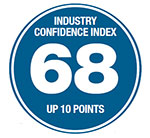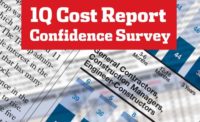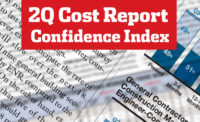Over the past two years, construction industry executives have observed that, after the 2007-10 recession, the market’s long recovery seemed to be running out of steam. But the unexpected election of Donald Trump last month has caused a surge in optimism that the recovery has not peaked and still may have legs.
 The ENR Construction Industry Confidence Index rose sharply for the fourth quarter. It shows that, of the 213 executives of large construction and design firms responding to the survey, most believe market growth will continue through the end of 2017. The CICI index was 68 on a scale of 100, up 10 points from the third quarter.
The ENR Construction Industry Confidence Index rose sharply for the fourth quarter. It shows that, of the 213 executives of large construction and design firms responding to the survey, most believe market growth will continue through the end of 2017. The CICI index was 68 on a scale of 100, up 10 points from the third quarter.
The CICI measures executive sentiment about the current market and reflects the respondents’ views on where it will be in the next three to six months and over a 12- to 18-month period. The index is based on responses to surveys sent out to more than 6,000 U.S. firms on ENR’s lists of leading general contractors, subcontractors and design firms from Nov. 16 through Dec. 14.
The new optimism cuts across all markets, with CICI ratings rising in this quarter for in each of its 15 market sectors. This uptick contrasts with the third-quarter survey, in which CICI ratings fell in 10 of the 15 sectors. Most execs polled in this quarter now see work in the sectors they serve continuing to grow through next year. Multi-unit residential is the only sector that execs see as going into decline in the next year to 18 months.
|
Click Here to View the 4Q Cost Report PDF |
CFMA Survey Also Shows Optimism
Also, the soon-to-be-released results of the latest Confindex survey from the Construction Financial Management Association, Princeton, N.J., show that, similarly, executives are more optimistic about what 2017 has in store. CFMA each quarter polls 200 CFOs from general and civil contractors and subs.
“The overall Confindex showed a significant gain in the fourth quarter, rising from 122 in the third quarter to 127,” says Stuart Binstock, CEO of CFMA. All four components of the Confindex rose in the fourth quarter, he notes. The “general business conditions” component was up six points, to 129; the “financial conditions” component was up four points, to 125; the “current market conditions” was up to 129 from 126, and the “year-ahead outlook” rose seven points, to 124, he says.
The presidential election seems to have spurred the growing optimism. “The survey results have a ‘Trump effect’ written all over them,” says Anirban Basu, CEO of economic consultant Sage Policy Group Inc., Baltimore, and CFMA adviser. He says industry execs love the idea that Trump has promised to cut regulations and increase spending on infrastructure. “Also, with a Republican Senate and House, he should be able to get more of his initiatives passed,” Basu says.
Another indicator of the “Trump bump” is from the National Association of Home Builders-Wells Fargo National Housing Market Index, which measures NAHB members’ optimism about the single-family-home market. On Dec. 15, NAHB announced the index hit 70 on a scale of 100, the highest it has been since July 2005.
Also, the National Federation of Independent Business (NFIB) Index of Small Business Optimism jumped 3.5 points, to 98.4, for November. The percentage of small businesses anticipating job creation compared to layoffs climbed up to a net 23% after the election from a net 9% before.
Skills Shortage Fears
But Basu says CFMA members worry that a steadily growing market will put pressure on labor and materials costs. He notes that 55% of respondents say margins are improving now, but only 40% say margins will continue to improve in the year ahead.
CFMA members have feared increasing costs from labor shortages for several years, Binstock notes, saying, “In the latest survey, 80% of our members said that the growing skills shortage is a major concern, up from 74% in the last quarter.”
The CICI survey gives credence to this concern. ENR asked whether survey respondents’ firms planned to add staff in 2017, 77.5% said yes. ENR also asked about planned raises in 2017. The average raise among the 180 firms providing estimate raises was 4.11%. Only one firm expected to cut pay in 2017.
A rising market also may raise materials prices. Nearly 60% of CICI survey respondents said they have seen upward pressure on materials’ costs. But there may be additional inflationary pressures. “The president-elect has spoken of more restrictive trade policies,” says Basu. The possibility of trade tariffs could raise prices of imported materials, such as copper and other metals critical to construction, he says.
Among market sectors, the biggest rating gain was the 13-point rise in the petroleum sector, based partly on OPEC’s decision to cut production to raise oil prices but also from the hope of a Trump administration’s more hands-off policy on energy. The power sector also rose sharply, rising 12 points, to a CICI rating of 67.
Also seeing significant gains were the civil sectors. Transportation was up seven points, to a CICI rating of 70, the highest among all market sectors. The water-and wastewater sector gained 10 points, to a rating of 67, and the hazardous-waste market was up eight points.
While not all survey respondents believe the Trump effect will result in long-term industry gains, most participants still see 2017 as a good year for key construction markets.





